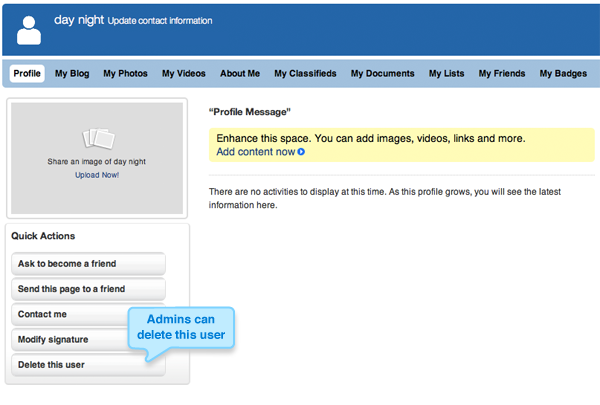For any number of reasons, a user may need to be disabled or removed from the system. There are several options here.
Administrators can set an expiration date for a user's account. This is important if the user has been granted temporary access to the system. Perhaps a consultant, vendor, or temporary employee. This is done in the Admin module on a per-user basis. The administrator can also disable a user when they no longer need access. This method maintains all of the user-generated content.
Sometimes users create accounts, they have passed the verification steps, and then they want to be removed from the site, or in the case of unwanted sign-ups, the user needs to be removed for business reasons. Business reasons can be as simple as spam accounts, those user accounts setup to link to other sites or generate content for the purpose of promoting products and services. In those cases, the user account was not setup for the purpose of collaborating and enjoying the site.
A new feature lets administrators go to the user profile in question, and then choose to delete the user. The user's profile is removed from the system completely, and their email address is marked as no longer acceptable. The user will not be able to login with that email address, nor can it be used for future access. Releated user-generated content is automatically removed.

View Full Post and Comments
ConcourseConnect has several features when it comes to user registrations.
On an open system, users are free to register and become users. There are two default safeguards: the first is that the user must correctly fill out a captcha, and the second is that the user must validate the account by following a confirmation link sent by email.
An additional option is for the administrators to approve all sign-ups. With this option enabled, the user signs-up as normal, and then the administrators receive the confirmation link in which they can approve or deny. This feature has proven useful for semi-open communities in which there public content and you want specific users to register.
Linking your site to Facebook's Login is another option. When you configure both the ConcourseConnect system and the Facebook API with your site's information, users are presented with an option to "Login with Facebook." This option allows users instant access to your site, while Facebook provides all of the validation and authorization of your users. I like this option because Facebook has already verified your user in some way.
ConcourseConnect also has its own token-based sign-up which allows for ConcourseConnect to be plugged into existing websites. In this case your existing site already has user logins, and with some basic programming, site users see a button, called anything you want, which allows one-click access to ConcourseConnect. The sites communicate user information behind-the-scenes and users flow freely from one site to the other.
Finally, a completely closed system means that only administrators and certain users with permission can invite users to the system. In this case the registration feature is turned off and users must fill out a request to become a user.
Now that you have users in your system, my followup blog post explains how to handle the ones that got through your filters.
View Full Post and Comments